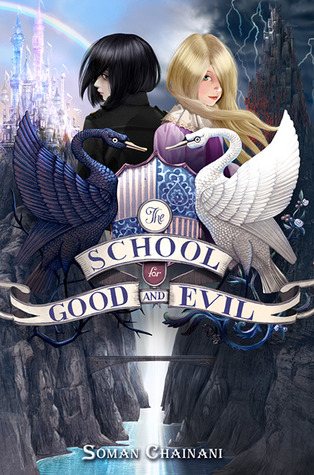*** Warning: This review contains spoilers! ***
 I really wanted to like this book. Isabelle reads so many books now that I can't keep up, but I specifically took the time to read this one because I wanted to see why Isabelle liked it so much. In the end, I was disappointed.
I really wanted to like this book. Isabelle reads so many books now that I can't keep up, but I specifically took the time to read this one because I wanted to see why Isabelle liked it so much. In the end, I was disappointed.
On the surface, this book had potential. Many aspects of the book struck me as derivative - two children regularly kidnapped from Gavaldon to be thrown into a life-or-death situation reminded me of the Hunger Games; the School for Good and Evil was reminiscent of Hogwarts; every student in the school had one special "talent", kind of like the X-Men - but I was willing to accept all that precisely because those ideas proved so thrilling in the other franchises. Unfortunately, once Sophie and Agatha were settled into their respective schools, the book just seemed like a big jumbled mess to me.
I appreciated the way the author incorporated a bit of humor every now and then, but for the most part, I was just confused. Very frequently, the book made mention of something or someone that only struck me as vaguely familiar; I was aware that I was supposed to know to what the book was referring, but whatever it was was usually something only briefly mentioned in a previous chapter, nothing that in any way appeared memorable the first time it was mentioned.
I felt like the bulk of the story just went on too long. Very early, we realize that Sophie was "mistakenly" placed in the School for Evil, and Agatha "mistakenly" placed in the School for Good. Agatha wants to go home, but Sophie wants to stay and prove that she belongs in the School for Good so that she can have her fairy tale happily ever after ending. We have several iterations of Sophie insisting she wants to stay, Agatha convincing Sophie they need to go home, and Sophie agreeing and working with Agatha, only to change her mind at the last minute. I started to wonder when things would actually start to progress one way or the other.
All along, the two possibilities were clear: either the girls' placements truly were mistakes, or the girls would realize that their placements were accurate. Of course, in the latter case, the situation would beg the question: Does this book really purport to segregate all people into black-and-white Good vs. Evil? Or will Sophie and Agatha somehow turn the fairy tale world upside down by showing that all people have some good and some evil in them?
I disliked the use of the word "Evil". In real life, I prefer words like "imperfect" or "flawed". In the fairy tale context, it made sense, but in the Sophie-and-Agatha-are-human context, it was really off-putting. I also really disliked the way the book equated Good with beauty. Agatha did have one isolated conversation with Professor Dovey in which they discuss that beauty is only skin deep, but it was hardly enough to counteract the premise of the rest of the book, which was that the students in Good were all beautiful, and the students in Evil were all ugly.
And speaking of Professor Dovey... She was only one of many characters who I had difficulty keeping straight. In my opinion, none of the students or teachers - except maybe Dot, Hort, and Tedros - were fleshed out enough so that I could identify them individually. Any time a name other than Sophie or Agatha came up, I had to stop and ask myself, "Okay, wait, is that person good or evil?"
In the end, we had the predictable lesson you probably suspected from the very beginning, but it was delivered too quickly. It felt like 99% of the book focused on the idea that every person is either Good OR Evil, there is no in between, it is your nature and you can't change it - and then only 1% of the book said, "Oh, never mind all that. We are all the same, just human."
The book ended so abruptly, it left me feeling dissatisfied. After Agatha and Sophie returned to Gavaldon, how would they explain everything to the other villagers? Will they be accepted back and honored? Or shunned for having crazy ideas? Can Sophie really find happiness living a "regular" life in Gavaldon, without a prince? And what about all the other students and teachers at the school? Will they all automatically give up their sides, and be one happy community in the woods? Even if all the students accept that they are all the same, neither all Good nor all Evil, how will they explain the new world order to their parents and neighbors back in their home villages? Maybe all these questions will be addressed in the sequel, which was just released, but at this point, I don't think I'll read it.
One final thought. While the main ideas of this book are appropriate for upper elementary school readers, it's probably better suited for middle schoolers because of the use of words like "murderer" and "cannibal" and at least one explicit killing.

